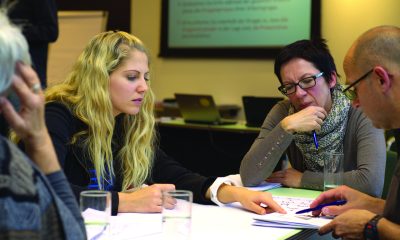Relationship
Understanding Group Dynamics in Building Meaningful Friendships

In today’s fast-paced and digital world, building meaningful friendships has become an essential aspect of our lives. The desire to connect with others and establish deep bonds is inherent in human nature. However, forging these meaningful relationships requires an understanding of group dynamics and the factors that contribute to their formation. In this article, we will explore the essence of building meaningful friendships and shed light on the process by incorporating the keyword “in Creating Meaningful Connections.”
When it comes to building friendships, group dynamics play a crucial role. Group dynamics refer to the patterns of interactions between individuals within a group. Understanding these dynamics is essential for creating an environment that fosters meaningful connections. By grasping the influential elements at play, individuals can navigate social situations more effectively, leading to the formation of genuine and long-lasting friendships.
The first step in understanding group dynamics is recognizing the diversity of personalities and backgrounds within a group. Each individual brings unique experiences, perspectives, and values to the table. Embracing this diversity allows for a richer exchange of ideas and fosters a sense of belonging among group members. By appreciating the differences, individuals can find common ground and build connections based on shared interests, values, or goals.
Another crucial aspect of group dynamics is effective communication. Communication serves as the foundation for any relationship, and friendships are no exception. Active listening, empathy, and open-mindedness are key components of successful communication. By truly understanding and valuing others’ opinions and feelings, individuals can establish deeper connections. The keyword “in Creating Meaningful Connections” emphasizes the importance of creating meaningful relationships through open and genuine communication.
Trust is also an integral part of group dynamics and friendship building. Trust is earned over time and relies on mutual respect, reliability, and confidentiality. Trust allows individuals to be vulnerable, share personal experiences, and feel comfortable expressing their true selves. By nurturing trust within a group, individuals can create an environment where meaningful friendships can flourish.
Furthermore, shared experiences contribute significantly to the development of meaningful friendships. Engaging in activities, working towards common goals, or facing challenges together strengthens the bond between individuals. Whether it is participating in a hobby, volunteering, or pursuing mutual interests, shared experiences provide opportunities for individuals to connect on a deeper level. “in Creating Meaningful Connections” highlights the importance of actively seeking out shared experiences to build meaningful friendships.
Lastly, maintaining a positive and supportive atmosphere within a group is vital. Encouraging and uplifting one another fosters a sense of belonging and creates a safe space for individuals to be themselves. By celebrating each other’s successes, offering support during difficult times, and cultivating a non-judgmental environment, friendships can flourish and thrive.
In conclusion, understanding group dynamics is essential for building meaningful friendships. By embracing diversity, practicing effective communication, fostering trust, engaging in shared experiences, and maintaining a positive atmosphere, individuals can create connections that are both fulfilling and long-lasting. The process of “in Creating Meaningful Connections” involves actively participating in group dynamics and nurturing relationships with sincerity and empathy. By doing so, individuals can forge meaningful friendships that enrich their lives and create a sense of belonging in an increasingly disconnected world.
Relationship
Building a Foundation of Innovation: Strategies for Effective Work Relations

In today’s fast-paced and competitive business landscape, innovation has become a key driver of success. Organizations that can foster a culture of innovation are better equipped to adapt to market changes, stay ahead of the competition, and deliver exceptional results. However, building such a foundation requires more than just creative ideas; it necessitates effective work relations. In this article, we will explore strategies that can help businesses establish and maintain strong work relations to fuel innovation.
First and foremost, communication is the cornerstone of any successful work relationship. It is imperative for leaders to promote open and transparent communication channels, ensuring that employees feel comfortable sharing their thoughts, ideas, and concerns. Regular team meetings, feedback sessions, and one-on-one conversations can help foster a collaborative and inclusive environment where innovation can flourish. By actively listening to employees’ insights and valuing their contributions, organizations can create a sense of ownership and trust, motivating individuals to think outside the box and propose innovative solutions.
Another crucial aspect of building effective work relations is promoting diversity and inclusion. Diverse teams bring together individuals with different backgrounds, experiences, and perspectives, which can lead to more innovative ideas. Encouraging diversity not only improves problem-solving abilities but also enhances creativity and fosters a culture of respect and understanding. By embracing diversity, organizations can tap into a broader range of perspectives and experiences, enabling them to tackle challenges from multiple angles and generate innovative solutions.
Furthermore, fostering a supportive work environment is vital for innovation to thrive. When employees feel supported, they are more likely to take risks, experiment, and explore new ideas. Leaders should create an atmosphere that encourages learning from failures and celebrates successes, fostering a growth mindset. Recognizing and rewarding innovative thinking and providing opportunities for professional development can also boost morale and inspire employees to push boundaries and think creatively. Additionally, establishing cross-functional collaboration and teamwork can facilitate knowledge sharing, spark new ideas, and encourage continuous learning.
Lastly, organizations should invest in creating a culture of empowerment. Empowered employees are more engaged, motivated, and committed to their work. By delegating authority, allowing individuals to make decisions, and providing autonomy, organizations can tap into the full potential of their workforce. Empowered employees are more likely to take ownership of their projects, think critically, and propose innovative solutions. Encouraging a sense of ownership not only drives innovation but also creates a sense of pride and loyalty among employees.
In conclusion, building a foundation of innovation requires effective work relations. Organizations must prioritize open communication, promote diversity and inclusion, foster a supportive work environment, and empower their employees. By implementing these strategies, businesses can create a culture that encourages innovation, enabling them to stay ahead in today’s rapidly evolving business landscape.
Relationship
Building Stronger Connections: Developing Effective Communication Skills at Work

Effective communication is the cornerstone of any successful workplace. It plays a crucial role in building stronger connections, fostering teamwork, and enhancing productivity. Developing effective communication skills at work is not only essential for professional growth but also for maintaining a positive work environment. In this article, we will explore some key strategies to improve communication skills in the workplace.
Active Listening: One of the fundamental skills to develop in effective communication is active listening. Active listening involves paying full attention to what others are saying, understanding their perspectives, and responding appropriately. By actively listening, we not only gather relevant information but also show respect and empathy towards our colleagues.
Clarity and Conciseness: Clear and concise communication is paramount in the workplace. Avoiding jargon and using simple language ensures that the intended message is understood by everyone. Additionally, organizing thoughts and ideas before communicating them helps to deliver messages more effectively and minimizes the chances of misinterpretation.
Non-Verbal Communication: Communication is not limited to words alone. Non-verbal cues such as facial expressions, body language, and tone of voice can greatly impact how a message is perceived. Developing an awareness of these non-verbal signals and mastering control over them can enhance the effectiveness of our communication skills.
Empathy and Emotional Intelligence: Empathy is the ability to understand and share the feelings of others. In a professional setting, empathy helps in building stronger connections and fostering a supportive work environment. Moreover, emotional intelligence, which includes self-awareness and the ability to manage emotions, allows individuals to communicate more effectively by understanding their own emotions and those of others.
Respectful Communication: Respectful communication is crucial for maintaining a healthy and productive work environment. It involves treating others with dignity, actively listening to their opinions, and refraining from interrupting or belittling them. By promoting respectful communication, individuals can build trust and collaboration among team members.
Feedback and Constructive Criticism: Providing and receiving feedback is an integral part of effective communication. Constructive criticism should be given in a considerate and respectful manner, focusing on specific behaviors or actions rather than attacking a person’s character. Receiving feedback gracefully is equally important, as it helps in personal and professional growth.
Technology and Digital Communication: In today’s digital age, technology plays a vital role in workplace communication. Emails, instant messaging, and video conferencing have become commonplace. However, it is crucial to use these tools judiciously and maintain professionalism in digital communication. Clear and concise written messages, prompt responses, and appropriate use of emoticons and punctuations are essential for effective digital communication.
Continuous Learning: Developing effective communication skills is an ongoing process. It requires continuous learning, self-reflection, and practice. Individuals should actively seek opportunities to improve their communication skills, such as attending workshops, reading relevant literature, or seeking feedback from colleagues or mentors.
In conclusion, developing effective communication skills at work is essential for building stronger connections, fostering teamwork, and enhancing productivity. Active listening, clarity and conciseness, non-verbal communication, empathy, respect, feedback, and continuous learning are key strategies to improve communication skills in the workplace. By incorporating these strategies into our daily interactions, we can create a positive and harmonious work environment that promotes professional growth and success.
Relationship
Effective Strategies to Sustain Employee Motivation in Long Term Work Relationships

Keeping Employee Motivation High is crucial for any organization to ensure productivity, employee satisfaction, and overall success. In long-term work relationships, it becomes even more important to maintain motivation levels to prevent burnout and maintain a positive work environment. This article will discuss some effective strategies that organizations can adopt to sustain employee motivation in the long run.
First and foremost, it is essential for organizations to provide employees with a clear sense of purpose and meaningful work. Employees are more likely to stay motivated when they understand how their contribution fits into the larger goals of the organization. Regular communication about the company’s mission, vision, and objectives can help employees understand the impact of their work, creating a sense of purpose and motivation to excel.
Another effective strategy is to provide employees with opportunities for growth and development. Long-term employees may feel stagnant in their roles, leading to a decline in motivation. Organizations should invest in continuous learning and development programs to help employees acquire new skills and knowledge. This could include training workshops, mentorship programs, or even educational allowances. By empowering employees to grow professionally, organizations can keep their motivation levels high.
Recognition and rewards play a crucial role in sustaining employee motivation. It is important for organizations to acknowledge and appreciate the hard work and achievements of their employees. Regular feedback, performance evaluations, and public recognition can go a long way in boosting motivation and job satisfaction. Additionally, implementing a fair and transparent rewards system, such as bonuses, incentives, or promotions, can serve as powerful motivators for employees to strive for excellence.
Maintaining a positive work culture is also vital in sustaining employee motivation. A supportive and collaborative work environment fosters motivation and engagement. Encouraging teamwork, open communication, and providing opportunities for employees to voice their opinions and ideas can make them feel valued and motivated to contribute their best. Managers should also lead by example, demonstrating professionalism, respect, and empathy towards their employees.
Furthermore, a healthy work-life balance is crucial for long-term employee motivation. Overworking employees can lead to burnout and decreased motivation. Organizations should promote work-life balance by offering flexible work arrangements, encouraging employees to take breaks, and ensuring reasonable work hours. This will not only help employees recharge and maintain their motivation but also foster a positive work culture.
Lastly, organizations must invest in regular employee engagement activities. Team-building exercises, social events, and community service initiatives can boost morale and create a sense of belonging among employees. Engaged employees are more likely to feel motivated and committed to their work, resulting in higher productivity and loyalty.
In conclusion, sustaining employee motivation in long-term work relationships requires a strategic approach. By providing a clear sense of purpose, opportunities for growth, recognition and rewards, a positive work culture, work-life balance, and engagement activities, organizations can keep their employees motivated and committed. Remember, motivated employees are the backbone of any successful organization, and investing in their well-being will yield long-term benefits.
-

 Parenting5 months ago
Parenting5 months agoScreen Time Guide for Children: Striking the Perfect Balance between Entertainment and Education
-

 Food & Drink6 months ago
Food & Drink6 months agoEnhance Your Culinary Skills: Mastering the Art of Transforming Ordinary Food into Spectacular Creations
-

 Work/Life9 months ago
Work/Life9 months agoBuilding Stronger Bonds: Strategies to Enhance Your Connection with Your Partner
-

 Relationship9 months ago
Relationship9 months ago7 Signs That You May Not Be Right for Each Other
-

 Travel8 months ago
Travel8 months agoUnraveling Bali’s Enigmatic Allure: Embarking on a Journey of Exoticism and Enthralling Activities
-

 Travel9 months ago
Travel9 months agoExploring the Beauty of Paris: Places You Must Visit
-

 Relationship9 months ago
Relationship9 months agoUnveiling The Art of Self Discovery How We Shape Our Identity
-

 Work/Life9 months ago
Work/Life9 months agoImproving Independence: Facing Life’s Challenges Resiliently





















